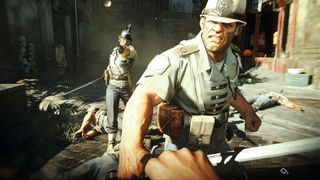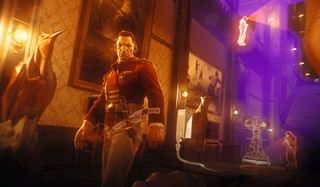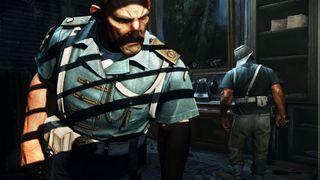Dishonored 2: creative killing in Karnaca
The sequel hopes to establish a spectacular new legacy for the stealth genre.

This article was originally published in PC Gamer issue 293. For more quality articles about all things PC gaming, you can subscribe now in the UK and the US.
The great old houses of the stealth genre are enjoying a long indian summer. Deus Ex has held on to its core values even as it adapts to the mainstream, and the latest Hitman episodes have absolved the series of, well, Absolution. Thief has struggled—after such a long absence, 2014’s patchy reboot was a let-down—but we haven’t needed Thief, really, since 2012. Dishonored’s claim to that particular throne was strong from the outset.
Soulful, clever and violent, Arkane’s new immersive sim revived the fantasy of the agent in the shadows. Yet Dishonored wasn’t special just because it resurrected an old legacy—it was special because it challenged it. Stealth games are always in some way about the fragility of power: in the dark you might as well be god, but exposed you’re just a person in formfitting leather. When Corvo Attano is granted his otherworldly powers near the start of the game, that changes.
In the dark he is a god, manipulating minds and bodies—sometimes literally—to bring about his revenge. In the light he’s a terror, slitting throats with impossible speed and freezing opponents in time before feeding them their own bullets. If the stealth game was traditionally about having godlike power that could be taken away by a stray beam of light, Dishonored was a little more open, more of a sandbox—about having godlike power in either case but being responsible for the world you bring about. It wasn’t just about continuing an old legacy—it was about creating a new one.
Set 15 years after the original game, Dishonored 2 is—in creative director Harvey Smith’s words—“the second half of the original story.” The assassination of Empress Jessamine Kaldwin at the beginning of Dishonored casts a long shadow. Jessamine’s daughter Emily is now 25 and Empress herself, and the game opens with you experiencing a day in her life in Dunwall, the setting for the first game. Then, perhaps predictably, something goes terribly wrong. Emily finds herself fighting back-to-back with her father, Corvo. (Arkane is being much more open about that particular detail this time around.) At this point you’re asked to choose: who do you want to control for the rest of the story?

Emily and Corvo both journey to a new city, Karnaca, and both encounter the same missions and enemies when they get there. Each brings a different perspective, however. Emily is a ruler without an empire, digging into both sides of her heritage—empress and supernatural assassin—as she explores a new kind of power. Corvo is getting old. “In Dishonored 2 he’s a man going home,” Smith says. “He’s getting older and deciding ‘how many more times can I protect my daughter?’”
Unlike the first game, which had a silent protagonist, both leads will speak in Dishonored 2. Emily is played by Erica Luttrell, Corvo by Stephen Russell. Yes, the same Stephen Russell who played Garrett in the original Thief games. I ask Smith if this choice was deliberate fan service, or—I don’t know—accidental fan service. He smiles. “It’s fantastic for us,” he says. “Early on in Dishonored 1, Raf Colantonio and I talked about giving Corvo a voice and ultimately decided to leave him a blank slate. But in our fantasy dream world, when we asked what he would sound like if he had a voice it was Stephen Russell—because we’re big fans of Thief and we just like his acting. But it never came together.”
PC Gamer Newsletter
Sign up to get the best content of the week, and great gaming deals, as picked by the editors.
Karnaca is rotting from within—there’s sickness, corruption, and a stark divide between rich and poor.
The team experimented with a voiced lead for the expansion Knife of Dunwall, and having decided to continue with this for the sequel Russell was the obvious choice. “For Dishonored 2 it was even more perfect,” Smith says. “We decided to have a voice, and Corvo is fifteen years older, and he’s a little world-weary... there was a magic synergy there.” (The last Russell-voiced Thief game was, if you’re wondering, twelve years ago.)
Luttrell and Russell are joined by a cast that includes Vincent D’Onofrio (Daredevil’s Wilson Fisk) as the Duke of Serkonos, Pedro Pascal as a gang leader, Sam Rockwell as a Dunwall city watchman, and Robin Lord Taylor (The Penguin in Gotham) as the new voice of the Outsider. Rosario Dawson plays Meagan Foster, captain of the Dreadful Wale—a hulking ironclad whaling vessel that the player uses as a base between expeditions to Karnaca.
Like Dunwall, Karnaca is rotting from within—there’s sickness, corruption, and a stark divide between rich and poor. The new city presents these themes in a new way, however. This is (or was) an opulent southern colony of the Empire. Tall pastel terraces line a bay at the fringe of deep jungle in the shadow of a mountain. It’s a little bit Havana, a little bit Barcelona, a little bit British Raj. There are rats (this is Dishonored, after all) but no plague. Instead, perennial infestations of bloodflies (think giant mosquitos) are getting worse. They lay their eggs in corpses. As crime and corruption create more bodies, the situation worsens.

This very much feels like a different place in the same world. Whale oil is a power source, but a less prevalent one than it was in Dunwall. In Karnaca, a cleft in the mountain channels wind down through the city. Here, walls of light and alarm systems are powered by turbines as often as explosive fuel. This impacts how you manipulate these devices and how they fit into the world.
Arkane is a relatively small studio and the different disciplines that go into creating a game world are closely linked to one another: history inspires concept art which inspires design which inspires the emerging history of the world which inspires concept art and so on. “Working with design on a daily basis, I can anticipate their needs,” says art director Sébastien Mitton. “It’s an organic process.”
He gives the example of the Dust District, an area of Karnaca in the shadow of great pipes that funnel dust from mountainside silver mines down the wind corridor and out to the bay. It started with the idea of a poor area choked by dust due to over-mining. Mitton’s team, accounting for the impact of wind on city streets, created a system of diamond-shaped city blocks flanked by massive wooden windbreakers: the kind of solution an intelligent architect might have devised to solve an environmental problem. These designs then inspired the way the area plays: the inside of each windbreaker offers a stealthy aerial route for subtle players, while the prevalence of rooftop power turbines offers a clue to the best way to subvert ground-level security devices. With flat rooftops comes increased guard presence at higher levels, however, making vertical exploration less secure than it was in the previous game. Periodically a distant horn heralds an incoming dust storm, at which point the entire district is shrouded in visionand- noise-obscuring ochre dust, perfect for an infiltration or a killing spree.
Many of these features are exclusive to the Dust District, which is only one of Dishonored 2’s dozen-or-so mission areas. The appeal of Arkane’s approach to worldbuilding isn’t just that they tailor the environment to offer specific opportunities to the player—all stealth games do that—but that they carefully consider why a city would be the way it is. These places are as impressive as they are because they emerge from a feeling and a sense of history as much as a game design need.
Arkane is using a new engine (Void Engine, based on id Tech 5) to enable better lighting and post-processing effects. Even so, Dishonored 2 is very much led by the same painterly sensibility as the first game. It’s a much better-looking game, but strict realism isn’t the goal—although some screenshots are surprisingly easy to mistake for concept art. Watching the Dust District mission play out in several ways, one thing that strikes me is the sense of heat. “Some senses work well in games,” Mitton says. “You have visual, sound, the vibration of your pad, but you miss the smell, the cold or the heat... It falls where?
Joining in 2011, Chris made his start with PC Gamer turning beautiful trees into magazines, first as a writer and later as deputy editor. Once PCG's reluctant MMO champion , his discovery of Dota 2 in 2012 led him to much darker, stranger places. In 2015, Chris became the editor of PC Gamer Pro, overseeing our online coverage of competitive gaming and esports. He left in 2017, and can be now found making games and recording the Crate & Crowbar podcast.
Most Popular


